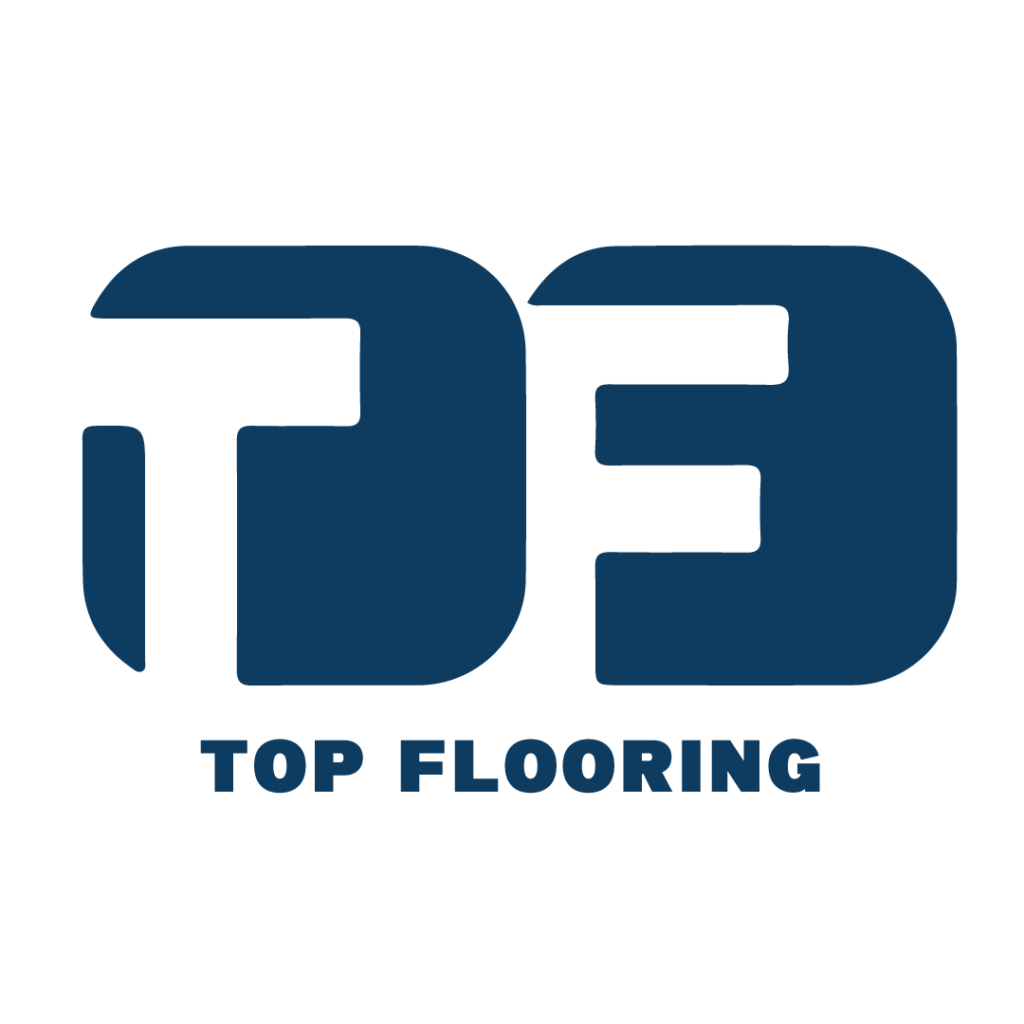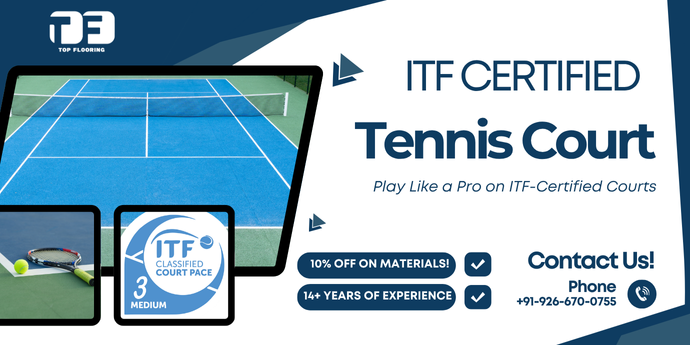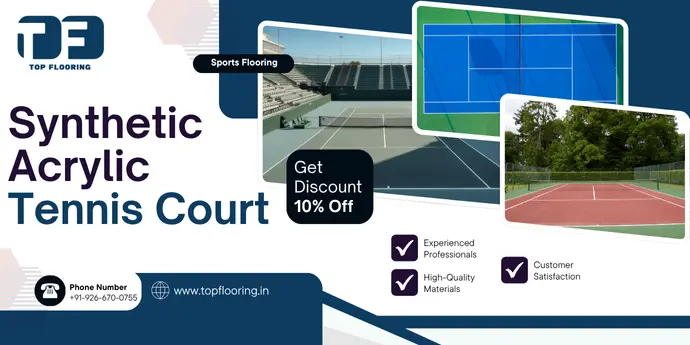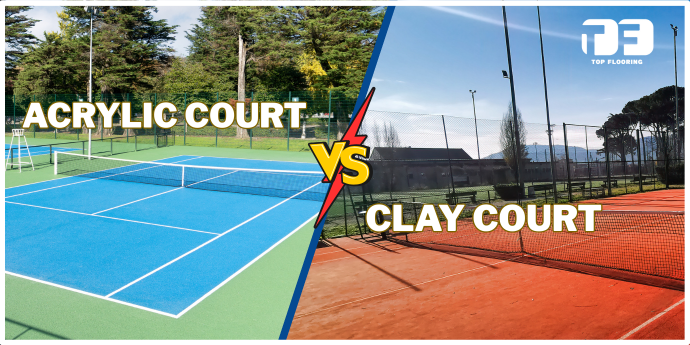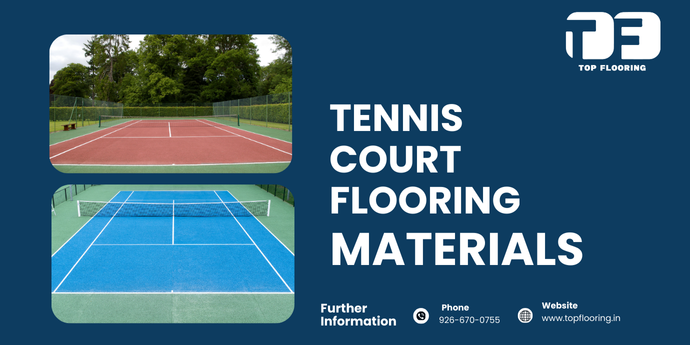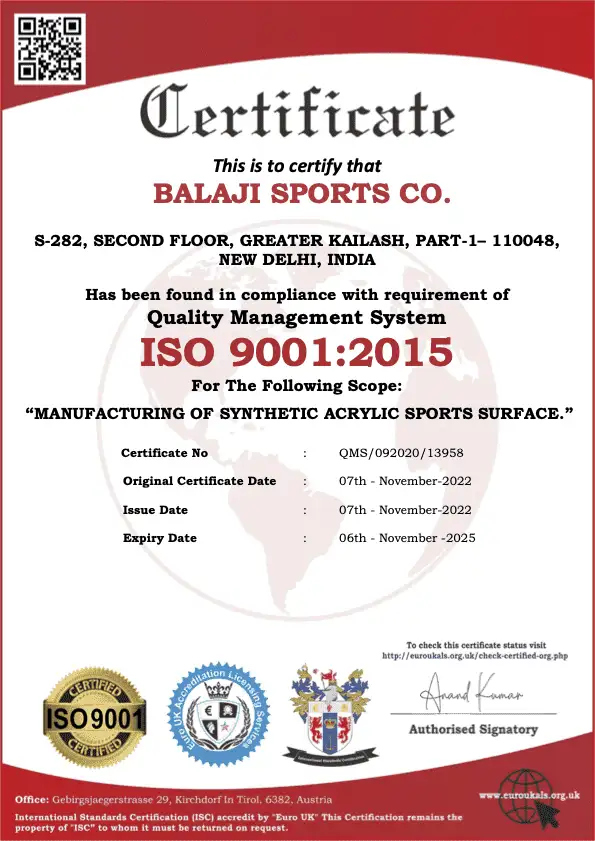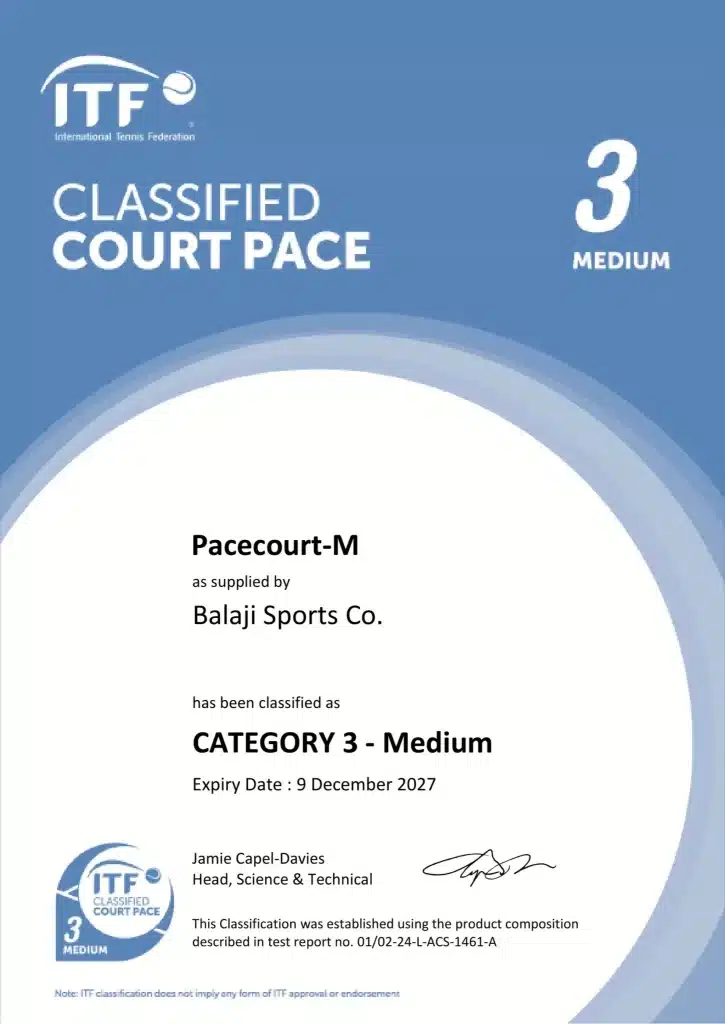Tennis is a sport of precision, pace and performance and the foundation of it lies beneath the players’ feet. Whether it’s a local club, an international academy or a private sports complex, tennis court flooring plays a huge role in how a game feels, performs and endures. The surface quality affects every bounce, rally and stride. But beyond appearance and color, surface pace, texture, friction and resilience lies. This is where the International Tennis Federation (ITF) comes in. The ITF certified tennis court surfaces through its Court Pace Classification System, so every professional court worldwide delivers consistent performance.
In simple terms, ITF certification means your court has been tested, verified and approved to meet the pace and safety expectations of international tennis. It’s the global benchmark for reliability and quality. Choosing the right ITF approved flooring and manufacturer means building trust, not just a tennis court. It’s an investment in consistency, durability and player safety for decades.
What is ITF Certification?
The ITF Certification is an official classification granted by the International Tennis Federation (ITF), A global governing body of tennis which ensures every tennis court surface around the world meets a uniform standard of pace, bounce, friction and safety.
In simple terms, when a surface or flooring system has an ITF certificate, it means it has been scientifically tested and verified to meet the performance requirements of professional tournaments and training facilities worldwide.
The Science Behind Certified Tennis Court Flooring
The International Tennis Federation (ITF) is the world governing body of tennis. One of its many roles is to maintain fair play through surface standardisation. For this the ITF developed a detailed Court Pace Classification Program (CPCP) that tests and classifies surfaces, based on their playing speed and texture.
The Five ITF Pace Categories
Each tennis surface is scientifically measured and placed in one of five pace categories:
| Category | Classification | Court Pace Index (CPI) | Play Style Description |
| 1 | Slow | ≤ 29 | High friction, slower rallies, ideal for control-based play |
| 2 | Medium-Slow | 30 – 34 | Balanced for all-round play |
| 3 | Medium | 35 – 39 | Most popular category; used in major tournaments |
| 4 | Medium-Fast | 40 – 44 | Quicker play, ideal for offensive strategies |
| 5 | Fast | ≥ 45 | Low friction, high-speed rallies, less reaction time |
These tests are not just based on visual inspection. But they are lab-measured using instruments that simulate real ball strikes, rebound angles and surface friction.
Category 3 vs Category 5 ITF Certificate: Customizing Play Speed
No two tennis courts are the same. A community club, a training academy and a professional tournament venue all demand different surface speeds. That is why the ITF Pace Classification System is very important. It allows each facility to choose the right category that matches their players, environment and objectives.
Category 3 – Medium Pace: The Global Standard for Balance
Courts in the Category 3 range (Medium Pace) offer the most balanced gameplay experience. The bounce is controlled, allowing players to play longer rallies without losing the thrill of fast exchanges.
- Ideal for schools, academies, residential clubs and multi-purpose facilities.
- Provides the perfect balance of speed, grip and cushioning for both beginners and experienced players.
- Reduces body strain during long sessions, making it a preferred option for regular training.
- Performs consistently across India’s varied weather conditions—from humid coasts to dry interiors.
In short, Category 3 is an “all-rounder” court that feels fast enough for competition but forgiving enough for daily practice.
Category 4-5 – Medium-Fast to Fast: For High-Performance Competition
At the upper end of the spectrum are Category 4 (Medium-Fast) and Category 5 (Fast) surfaces. These courts are for players who love aggression, quick serves and rapid baseline rallies.
- Favored by elite academies, professional tournaments and advanced players seeking high-intensity play.
- Lower surface friction means faster ball speed and shorter reaction time.
- Demands more precision and athleticism, simulates the pace of ATP and WTA matches.
- Requires expert installation and maintenance to maintain surface uniformity at such high speeds.
While these fast categories are thrilling, they are best suited for controlled, competitive environments with skilled players.
Why Top Flooring chooses Category 3 for India?
Top Flooring’s acrylic tennis court systems are designed for Category 3 (Medium Pace) — the most popular and widely accepted category globally. This category fits India’s sports ecosystem where facilities cater to diverse groups: students, recreational players and professional trainees alike. It’s versatile—one court for practice and tournaments.
- Player comfort during long coaching hours.
- Durability and pace consistency under India’s sun, monsoon and dust.
Top Flooring courts balance speed, comfort and control to give you professional grade play with practical, sustainable and affordable for every project.
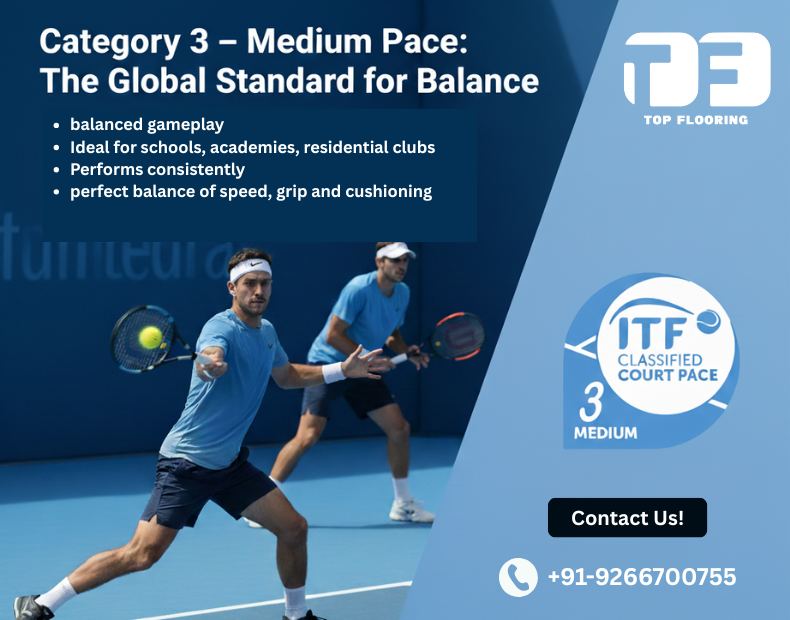
What ITF Certification Means for Your Court?
When a product is ITF-certified, it means the tennis court surface material has been tested for:
- Consistent Ball Bounce
Every certified surface is tested to ensure a uniform and predictable rebound. So a player’s technique, not surface irregularity, decides the outcome. - Uniform Friction Levels
The surface is engineered for a balanced mix of grip and glide. Players can slide, stop and pivot without sudden slips or excessive drag, resulting in smoother movement and better reaction control. - Shock Absorption and Comfort
ITF-rated systems have cushioning properties that reduce impact stress on knees, ankles and hips. This reduces player fatigue and prevents long term injuries — a must for training academies and frequent players. - Weather and UV Durability
Certified materials are put through accelerated aging and UV resistance tests, to prove their ability to withstand extreme temperatures, rainfall and sunlight. This ensures long lasting performance, color stability and surface integrity.
These tests form a data-backed performance guarantee that your court won’t just look good — it will play well, every day, regardless of climate or usage. Whether it’s summer heat, coastal humidity or heavy rain, an ITF-certified surface will retain its bounce, traction and finish much longer than conventional coatings.
Top Flooring’s ITF Promise
Top Flooring’s synthetic acrylic tennis court systems are designed to meet the ITF Category 3 (Medium Pace) standard — the most popular and versatile globally. This pace level is the perfect balance of speed and control, ideal for clubs, academies, residential complexes and professional training centers.
Every Top Flooring surface is made with precision formulated resins, silica and elastomeric compounds tested to international specifications. The result is a court that not only meets ITF standards but also thrives in India’s climate — so you can play consistently at a professional level for years to come.
Benefits of Choosing ITF-Rated Flooring
1. Consistency Across Climate and Play Levels
India’s climate from Rajasthan’s dry heat to Kerala’s monsoon humidity is challenging for outdoor courts. Non-rated paints or local coatings often blister, crack or fade under these conditions. ITF-certified tennis court materials are designed with weather resistant and balanced silica ratios for uniformity in all conditions.
- Surface pace remains the same whether you play in 45°C heat or post rain humidity.
- Acrylic coatings resist UV degradation, and do not fade color.
- Proper curing and polymer formulation keeps the surface flexible enough to handle thermal expansion without cracks.
That’s why professional tennis court contractors prefer ITF-certified systems— they perform across regions and elevations.
2. Players Comfort and Safety
Tennis is a demanding sport with quick turns, slides and jumps. Bad flooring can lead to knee, ankle or back injuries.
An ITF approved tennis surface has cushioning and elastomeric layers that absorb impact and reduce shock to the body.
- This reduces muscle fatigue and joint stress during long matches.
- Controlled friction gives just enough grip without burning or slipping.
- The cushioned feel allows players to play longer hours without strain.
This is why ITF rated courts are the perfect choice for tennis academies, schools and residential clubs where comfort and safety is top priority.
3. Long-lasting and Low Maintenance
Building a tennis court is a long term investment so durability matters. ITF tested materials use UV resistant acrylics, high grade polymers and weatherproof silica aggregates that perform for years.
- Minimal resurfacing needed: A well built ITF acrylic court may only need resurfacing once every 6-8 years.
- Less cracking and fading: The material adapts to micro movements of the base and maintains elasticity.
- Lower lifetime cost: The initial tennis court construction cost may be slightly higher but long term savings are substantial.
Compared to ordinary concrete paint or rubber based coatings, ITF certified flooring reduces the tennis court maintenance cost over its life.
4. Professional Play Experience
Every major tournament from the Australian Open to the US Open uses ITF rated surfaces. Players develop their rhythm and strategy based on how a certified court plays.
When clubs or schools use ITF tennis court flooring, they replicate this professional experience.
- Uniform ball response gives players predictable play conditions.
- The surface supports tournament level performance and training accuracy.
- It elevates the facility’s reputation, attracting more members and players.
For aspiring pros, training on such courts develops muscle memory, reaction time and adaptability essential for advancing in the sport.
How ITF Testing Ensures Quality and Performance?
Before a tennis surface is ITF certified, it must go through a rigorous scientific testing process. The International Tennis Federation (ITF) doesn’t rely on visual inspection or marketing claims. But it tests every surface using precise, repeatable laboratory tests designed to simulate real world play. This is the Court Pace Classification Program (CPCP). It tests everything from bounce and friction to weather resistance and long term durability. This is easy to ensure that every ITF-rated court offers the same level of performance, comfort, and safety anywhere in the world.
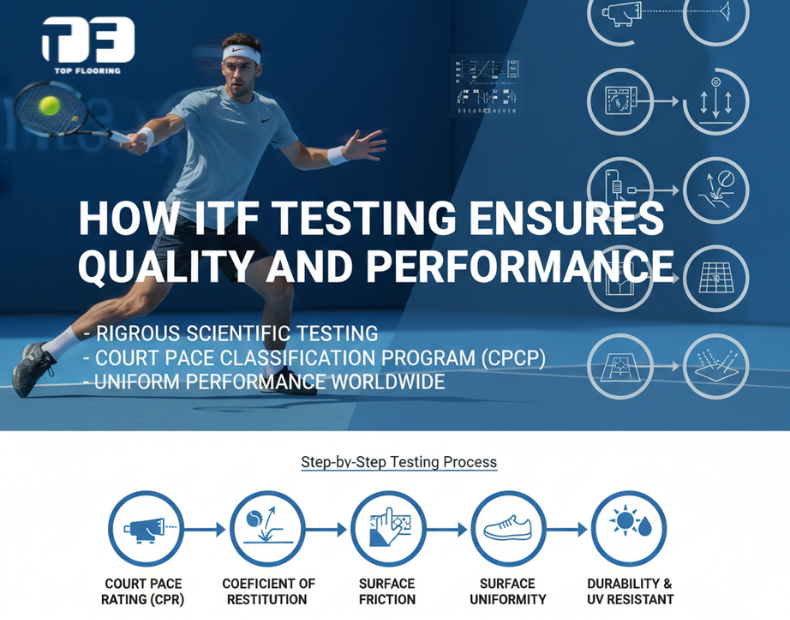
Step-by-Step Testing Process
The ITF’s Court Pace Classification involves advanced scientific measurements to test performance. Here’s what happens before a material gets certified:
1. Court Pace Rating (CPR) Test
A special air cannon shoots a tennis ball at a controlled speed onto the surface. Electronic sensors measure the incoming and outgoing speeds of the ball to calculate the Court Pace Rating (CPR) and the number that determines whether a surface is slow, medium or fast. This ensures a fair balance between play speed and control.
2. Coefficient of Restitution (Ball Rebound)
This test measures how much energy the surface gives back to the ball upon impact. A higher coefficient means a livelier bounce, a lower one means slower, more controlled rallies. The result affects how high and how fast the ball bounces across the whole court.
3. Surface Friction Test
Friction is how much grip the surface gives to both players and the ball. Too much friction makes the court “sticky” and increases injury risk, makes it slippery and the ball slides unpredictably. ITF labs use drag-measuring devices and motion analysis systems to fine tune this balance between traction and glide.
4. Shock Absorption Measurement
This test measures how well the surface absorbs the impact energy generated during running and jumping. Proper shock absorption reduces stress on the knees, ankles and spine during long sessions. It’s crucial for academies and pro venues where players train daily.
5. Surface Uniformity and Evenness Analysis
Every part of the court must behave the same. Using laser profiling or straightedge measurements, engineers check the whole surface for dips, bulges or “dead spots”. Uniformity ensures predictable bounce and safe player movement across all zones, baseline, service box and net area.
6. Durability and UV Resistant Simulation
Courts are subjected to accelerated aging tests, exposed to intense sunlight, moisture and temperature variation. This simulates years of outdoor use in just weeks. A surface that maintains its colour, texture and elasticity through these conditions proves its long term stability and resistance to cracking or fading.
Only when a surface meets or exceeds all ITF defined limits in these categories. And make the ITF classification label, a global mark of credibility and technical excellence.
Materials Used in ITF-Certified Courts
Each certified surface is a multi layered system made with engineered materials for durability, performance and climate adaptability.
1. Acrylic Resins
The base of every acrylic tennis court these resins create a smooth yet tough film that bonds to asphalt or concrete bases. They provide flexibility to accommodate expansion, UV resistance and a consistent finish over time.
2. Silica Sand (or Quartz Aggregate)
Silica sand controls surface texture and pace. Fine sand produces a smoother, faster court, while coarser sand increases grip and slows the game. The ratio of silica to resin determines how the ball interacts with the surface and how players move across it.
3. Cushion Compounds
These are elastomeric layers of flexible coatings that provide shock absorption and comfort.
Especially important for academies, schools and professional facilities where reducing joint impact and fatigue is crucial.
4. Color Coats
These final layers give the court a professional look. Pigmented with UV resistant colours to prevent fading. The surface will look great even after years of use under the Indian sun. Beyond aesthetics, color coats also contribute to pace and grip calibration.
5. Line Marking Paints
Precision matters in every serve and rally. Line marking paints provide maximum brightness, anti-slip finish and abrasion resistance, visibility even after thousands of foot movements and ball strikes.
Why This Testing Matters for Players and Owners?
Each test, layer and material plays a unique role in ensuring a tennis court isn’t just playable but professionally engineered.
- For players, ITF testing ensures safe footing, predictable play and injury prevention.
- Whereas for coaches and academies, it guarantees consistency for training and tournament level accuracy.
- And For facility owners, it confirms that their investment meets international performance and durability standards, reducing tennis court maintenance costs and extending resurfacing intervals.
When combined with proper construction techniques and expert installation. These certified materials deliver courts that perform flawlessly year after year. No matter the climate or intensity of use.
Why the Manufacturer Matters as Much as the Material?
ITF certification ensures the material, but not the installation. Even the best acrylic will fail if not done right. That’s why the manufacturer matters.
The Difference Between Reliable Manufacturers and Local Vendors
| Reliable ITF Manufacturer (like Top Flooring) | Local Paint Vendor |
| Uses ITF-classified resins and silica blends | Uses untested paints or industrial coatings |
| Provides on-site application guidance | Lacks technical support or supervision |
| Maintains batch consistency and testing | Variable composition and poor quality control |
| Offers long-term warranty and maintenance support | No after-sales support |
| Trained applicators ensure correct layering | Labor often lacks sports-flooring expertise |
Choosing a local vendor might save a few thousand rupees initially but the surface fades, cracks and loses friction within a year. Certified tennis court manufacturers on the other hand maintain strict quality control so your court meets ITF pace and durability standards for years.
What Makes a Manufacturer Trustworthy?
A reliable tennis court manufacturer should have:
- In-house testing and R&D labs for batch validation.
- Experienced installation teams trained in sports flooring protocols.
- Verified ITF test reports and certifications.
- Nationwide dealer support for faster supply and service.
- Guidance on slope correction, base preparation and layer application.
This is where Top Flooring excels — delivering an end-to-end partnership from material selection to project execution.
What to Look for in an ITF Certified Tennis Court Manufacturer?
When planning a new court or resurfacing project here’s what to look for in a manufacturer:
- Experience in Sports Construction: Years of specialization in acrylic tennis court construction and successful project history.
- Certified Systems: Availability of test reports and pace classification details from ITF labs.
- Climate Adaptation: Ability to design materials suited for India’s hot, humid and dusty conditions.
- Technical Guidance: Assistance with tennis court base construction, leveling and slope management.
- Resurfacing Support: Availability of tennis court resurfacing materials and repair services when needed.
- Customization Options: Choice of colors, pace levels or cushion thickness.
- Warranty Coverage: Written guarantees on adhesion, performance and color retention.
A manufacturer that fulfills all these parameters not only ensures product quality but also long term performance consistency.
Why Top Flooring Is the Ideal ITF Tennis Court Manufacturer in India?
Made for India’s Climate
India’s climate can be brutal on outdoor sports surfaces with its extreme heat, heavy monsoon rains and high humidity. Top Flooring’s acrylic tennis court systems are designed to withstand all this. Each formulation is using advanced polymers that resist thermal expansion, cracking and fading. Whether a court is installed in the dry heat of Delhi, the coastal moisture of Chennai or the seasonal rains of Pune the surface remains stable, smooth and playable all year round. This climate resilient performance means facilities all over the country can have long lasting courts that look as good as they play.
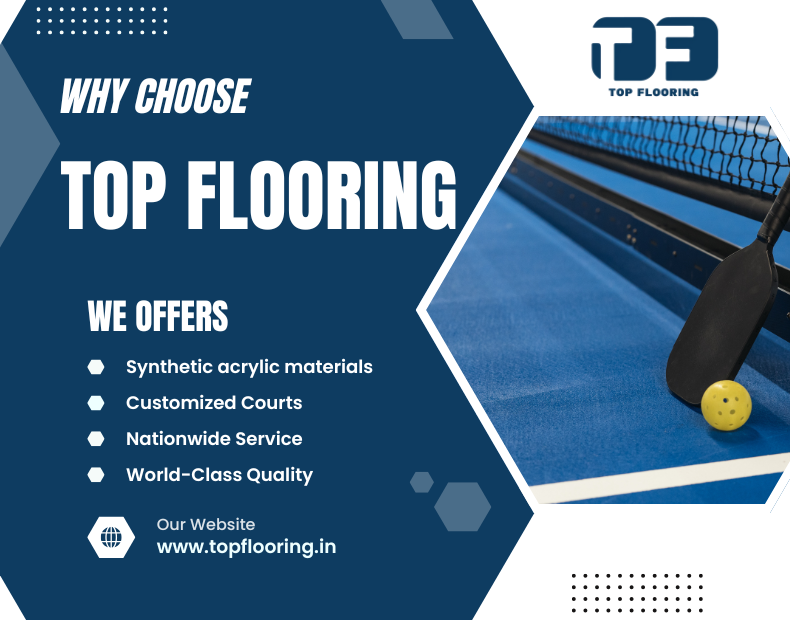
Precision Formulation and Quality Control
Quality begins with precision. At Top Flooring every batch of material goes through a strict R&D and quality testing process before it leaves the factory. Our labs test parameters like friction consistency, UV stability, elastic modulus and adhesion strength to ensure the material meets ITF approved performance in real world conditions. This in-house testing delivers every surface the same bounce, pace and comfort whether it’s built in a school, academy or sports complex. Uniform playability is the foundation of ITF standards—and that’s exactly what every Top Flooring court provides.
Professional Installation Network
Even the best materials need skilled application. That’s why Top Flooring works with a nationwide network of certified tennis court builders and infrastructure experts. Our applicators are trained to follow exact mixing ratios, layer thicknesses and curing conditions for ITF compliant systems. Each project is monitored to achieve perfect leveling, consistent coating density and seamless finishing. This attention to detail ensures every court meets technical standards and looks world class so players and owners can be proud of.
ITF-Standard Systems
Top Flooring’s acrylic systems are built to ITF Category 3 (Medium Pace)—the global preferred pace for speed, safety and playability. Courts built with our materials have smooth, predictable bounce and optimal traction for players of all levels. These surfaces are known for their durability, vibrant appearance and long life, performing well in training academies and professional tournaments. With our ITF standard flooring every match feels consistent, competitive and fair.
End-to-End Expertise
Top Flooring offers complete project management from start to finish so every court is engineered for peak performance. Our expertise covers every stage of construction, from base design and drainage planning to final line marking. The process begins with concrete or asphalt base consultation, followed by a precise sequence of primer, resurfacer, cushion, color coats and line marking applications. Our on-site technical supervisors ensure each layer cures properly and all materials are applied under optimal weather conditions. This full spectrum support allows clients to focus on results while we handle the technical precision behind every perfect bounce.
Proven Trust & National Presence
Over the years Top Flooring has become one of India’s most trusted names in tennis court construction. Our projects are across sports academies, universities, housing societies, clubs and recreation centers where thousands of players train and compete on our surfaces every day. Each court is a reflection of our promise, durability, consistency and ITF certified tennis court performance. Through reliable execution, nationwide service and continuous innovation Top Flooring sets the benchmark for professional grade tennis court flooring in India.
Why Partner with Top Flooring?
- Seamless Coordination: From material supply to installation guidance, on time completion.
- Fast Delivery: Ready stock of coatings and aggregates.
- Value for Money: Long term savings through less maintenance and resurfacing.
- Custom Colors and Pace: Multiple ITF certified tennis court surface options.
- Eco Friendly: 100% water based, low VOC, non toxic.
- Low Maintenance: Easy cleaning and quick repairs.
With Top Flooring you get more than just materials but you get a professional.
The Future of ITF Tennis Courts in India
Growing Demand Across India
The Indian sports landscape is changing fast. Tennis was once considered a niche or elite sport and is now spreading across schools, universities and residential complexes in every region. As this growth happens, the demand for synthetic tennis court flooring has seen a huge surge. Modern institutions no longer see courts as luxury add-ons — they see them as essential infrastructure for youth development, recreation and health.
From small town coaching centers to metropolitan sports complexes, facility owners are moving away from temporary paint coatings to long lasting ITF certified acrylic surfaces. The focus has shifted to safety, durability and consistent play quality — exactly what professional players train on worldwide. This nationwide shift is not just a boom in tennis infrastructure but a move towards global standards of construction and performance.
Government and Private Investment
Public initiatives like Khelo India and Fit India Movement have become powerful catalysts for sports infrastructure development. These programs emphasize physical fitness and talent identification at the grassroots level, creating an urgent need for standardized, certified courts across the country.
Government tenders, educational institutions and municipal projects now often require ITF rated flooring systems for approval and funding. In parallel, private developers, academies and real estate groups are investing heavily in multi-sport facilities that include tennis courts built with international specifications. This combination of public funding and private innovation is rapidly making India a hub of professional quality sports infrastructure.
For Top Flooring, this is an exciting opportunity to set new benchmarks in affordable high performance tennis court construction. With its proven track record, technical expertise and ITF aligned systems, Top Flooring will continue to help India build courts that match global standards.
Sustainability and Innovation
As India’s sports infrastructure grows, it is important to focus on sustainability. Modern sports facilities are performing well and also minimize environmental impact. The future of tennis court construction is in eco friendly materials and energy efficient design innovations.
Today’s courts are using water based acrylic formulations that emit fewer volatile organic compounds (VOCs), ensuring player safety and environmental protection. Many are designed with recyclable silica aggregates and eco friendly binders reducing waste and promoting circular material usage. And technology is also changing how courts work, from LED perimeter lighting for energy efficient lighting to permeable base systems that reduce waterlogging during monsoon seasons. These modern features extend the life of the court, improve performance and reduce maintenance costs.
Top Flooring is at the forefront of this green revolution. Every surface developed by the company combines ITF certified tennis court performance with eco innovation, so future courts are not only professional but also sustainable. By leading this shift towards environmentally responsible construction, Top Flooring is helping India build a generation of tennis courts for athletes and the planet.
Conclusion
A tennis court is not just a play area, it’s a long term asset that reflects quality, precision and passion. The difference between a fading, cracking surface and a professional grade court lies in one decision. Choosing ITF certified tennis court flooring from a reputed manufacturer.
Top Flooring delivers that. Every layer delivers durability, safety and pace control. Every project is backed by technical expertise, on site guidance and nationwide support. Whether you’re a sports academy, real estate developer or institution, partnering with Top Flooring means peace of mind, long term performance and global standard playability.
Invest in a court that matches international standards. Choose ITF certified tennis court flooring from India’s leading manufacturer – Top Flooring.
Frequently Asked Questions
It’s an official approval by the International Tennis Federation confirming that a tennis court surface meets global standards for pace, bounce, and safety.
It ensures consistent ball bounce, grip, and durability, giving players a reliable and safe playing experience.
ITF-approved surfaces are Acrylic hard courts, synthetic cushioned systems, artificial clay, and turf courts can all be .
It offers professional-quality play, consistent performance, and reduced injury risk for players in training.
Check the official ITF Court Pace Classification list or request the manufacturer’s ITF test report.
Yes, Top Flooring provides ITF Category 3 acrylic systems designed for medium pace and Indian conditions.
ITF Category 3 (Medium Pace) is ideal for India’s climate, offering balanced speed, comfort, and durability.
